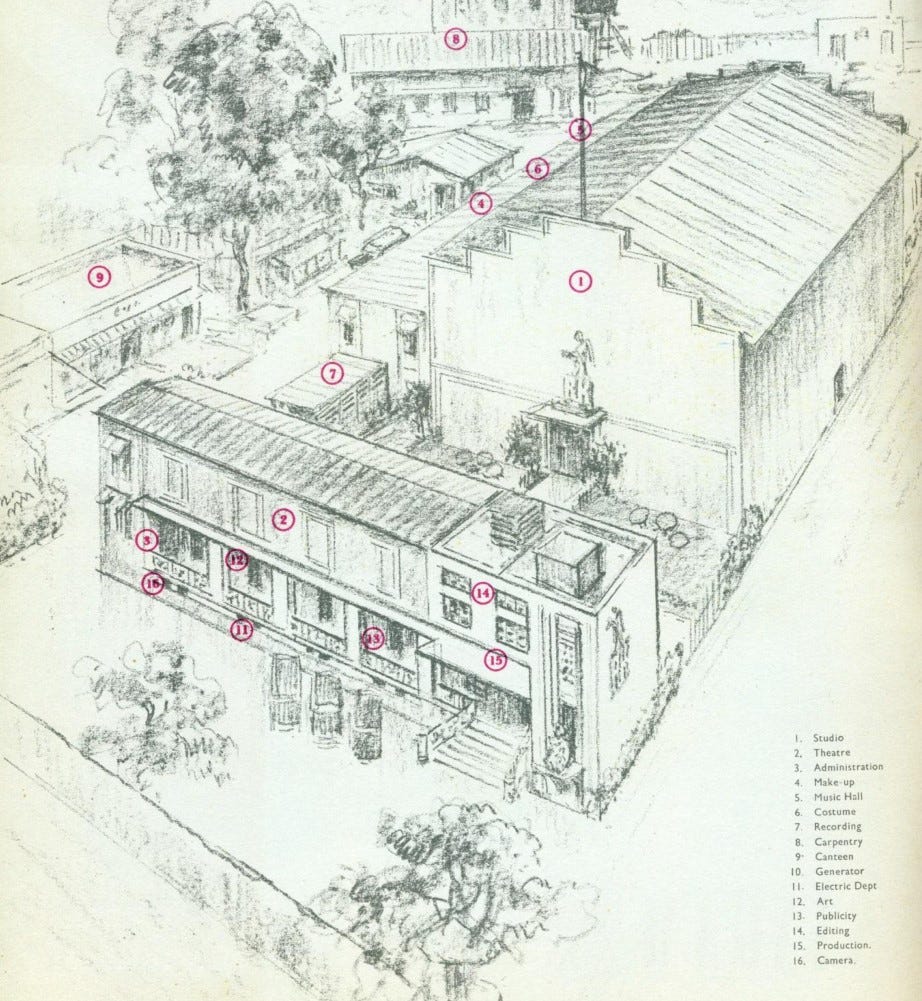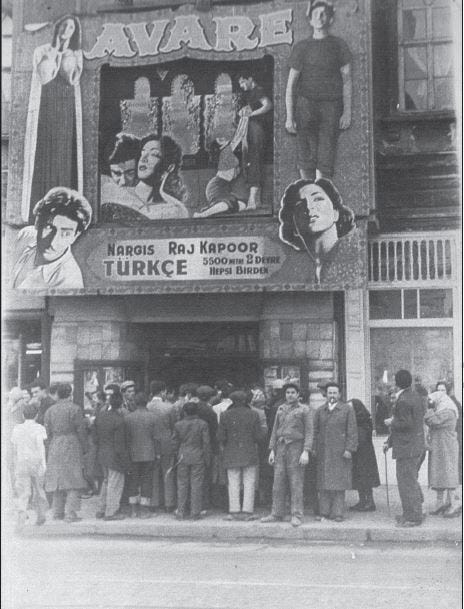“You are amazed by his fantastical imagination that visualized the surreal setting, the ethereal Nargisji emerging through thick clouds of smoke, Rajji surrounded by demonic figures and burning fires – there is a powerful, mystical symbolism in the dream sequence, and that is my favourite.”
Mr Amitabh Bachchan said on December 14, 2024, on the re-release of Raj Kapoor’s classic movie: Awaara.
It is a pity that Mr Bachchan did not dig any deeper. Had he paid attention to the credits of Awaara, right in the beginning, it acknowledges the following:
Executive message: Raj Kapoor did not dream up the dream sequence.
Background of Awaara
It was a two year project that Raj Kapoor put in a lot of blood, sweat and tears. In order to control the process of moviemaking, Raj Kapoor had an ambitious plan. He bought a piece of land and constructed the entire RK Studios in Chembur, Bombay.
It had everything built inside. He constructed movable realistic sets that can be repurposed for different movies. He even offered Satyajit Ray to use it for Pather Panchali. Ray politely declined.
The Dream Sequence
If we examine Awaara’s dream sequence, it can be divided into three segments. Earth, Hell and Heaven. There are three songs together: "Tere Bina Aag Yeh Chandni", "Mujhko Chahiye Bahar" and "Ghar Aya Mera Pardesi."
The sequence itself is a summary of the entire movie - the redemption of the main character even though he could not escape his past sins.
If we examine the dance movements in the first four minutes, we find the elaborate sets of dancers on thirteen different platforms performing graceful hand movements.
All the accompanying music is very Western with dozens of violins. The dance, however, is very Indian classical.
In the second act of hell, we note the emergence of papier-mâché as elaborate props in a French style.
In the final segment, we see the emergence of Lord Shiva as the savior of the main character with the help of Rita.
The giant Nataraja dominates the dancers and Rita. The two characters walk down the zigzagged road to salvation.
Awaara with shades of the Uday Shankar movie Kalpana
In 1948, Uday Shankar created his masterpiece - Kalpana. It is not a movie with a straight narrative. It is an experimentation. It involved short stories, elaborate Kathakali, Manipuri dances along with a heavy dose of surrealism. In a remarkable cross fertilization of dance movements, he got the Kathakali dancers perform the Manipuri movements to create a new genre of dance. He created a new form of hand movement that permeates the entire movie of Kalpana.
He then went on to incorporate an entire set of surreal movements where disembodied hands create joyous music. It was very Luis Buñuel-esque without the gore. The idea was to “promote and create a propaganda for art and culture,” declared Uday Shankar.
The Real Madame Simkie
Simone Barbier was born in 1910 in France. The daughter of a pianist, she studied piano before enrolling at the Jeanne Ronsay dance school, where she learned various “exotic dances”. It was there, at the age of 16, that she met Uday Shankar, who was invited to teach at the school.
She first helped him convert Indian music to the piano and then became his student. Shankar renamed her Simkie. She was “reborn” as an Indian. On December 15, 1928, Simkie and Shankar appeared together on stage at the 2000-seater Salle Pleyel.
The young dancer also assisted him in his choreography. This is how Simkie turned, definitively, to Indian dance and devoted her entire life to it.
This was the second phase of Uday Shankar when he started his own company in Paris and played to packed auditoriums in the Avenue des Champs-Élysées. The demand for the tickets were so high that the riot police had to intervene.
Kalpana and Awaara Dream Sequence
If you watch Kalpana you see many elements showing up in the movie Awaara’s dream sequence - not the least - the surreal dances. This was incorporated directly by Madam Simkie. The original idea goes back to Uday Shankar. It did not come from Raj Kapoor at all. The hand gestures I referred to earlier and the use of papier-mâché came from Madame Simkie - the first from Uday Shankar himself and the second from her working closely with Uday Shankar in Paris.
A Look Behind the Scene of Awaara Dream Sequence
Raj Kapoor was fully in control of the production. Khwaja Ahmad Abbas penned the story. But, then Raj Kapoor incorporated different elements. The dream sequence took three months of shooting - an expensive project in itself. He had an exposed film of 80,000 meters for Awaara from which he carefully picked 4,700 of them. We only see less than six percent of the entire film today. We will never know what was left on the cutting floor.
Set design - the use of dry ice
The sets were designed by Murlidhar Ramachandra Acharekar. Radhu Karmakar, director of photography noted: “Fortunately, I had a chemist friend working at Bengal Chemical who suggested using solidified carbon dioxide and ice. We tested it and found that it produced the best effect... even I was surprised by the superb perfection of the entire sequence.” As a result, you see almost a third of the screen covered by the white cloud of dry ice in many parts of the dream sequence.
Dry ice is not innocent
Dry ice is dangerous. It is full of carbon dioxide. Inhaling large quantities of it can cause severe damage to the lungs. You have a large group of dancers - and a room filled with dry ice - with zero ventilation - you have a problem. It was precisely the problem that some dancers face. They fainted: the outgassing caused hypercapnia.
Raj Kapoor’s reflection on Awaara
“They say I wasted money – they might have liked me to make a mediocre film. They criticize the story of Awaara – they probably would have preferred a usual love triangle.”
It was a huge gamble for Raj Kapoor. There was no guarantee of success. Initial indications were not good.
Khwaja Ahmad Abbas reflected on it in his autobiography:
Raj Kapoor took two years to produce Awara. It was a unique production— it had all my scenes and dialogue, but it was embellished by Raj Kapoor’s own comedy (ouches, songs and dances which Raj made pertinent to the story — specially the reel-long “dream sequence” for which he engaged Madame Simkie, till recently the partner of Uday Shanker, to do the choreography.
I remember the night it was premiered. The whole industry was invited. After the show everyone walked out in silence, shaking hands with Raj Kapoor who was standing by the door, tense with suspense, as if to console him rather than congratulate him, “Well,” they seemed to say, “It happens to the best of us. Flops come in the wake of hits!” The same night, at a cocktail party that had already been arranged, a distributor-financier told Raj in my hearing, “Well, that should teach you not to dabble in progressive and purposeful stories.”
When everyone was gone, Raj asked me and Sathe, “Tell me, please. Is our picture so bad?”
I told him it wasn’t bad at all. Personally, I was proud of it. The way he had directed and produced it, sparing neither money nor hard work, it was more than any writer had the right to expect. As for being a hit, I asked him to wait for the next day — let the people give their verdict!
They did, and it was a stupendous hit. The people did not mind the “progressive” story and dialogue. There were no awards in those days. But if there were, I am sure Awara would have swept the board and been acclaimed as the year’s best film.
Awaara’s international success
Awaara ended up making over two hundred and thirty million dollars in today’s money. It made twice as much in the Soviet Union. It was also a hit in China and Turkey. The vagabond had international appeal. Khwaja Ahmad Abbas:
In the autumn of 1954, the entire Soviet Union was shaken by a minor revolution. It was caused by a young Indian in ill fitting Western clothes, a tramp by his appearance, a pick-pocket by profession, but a gay, compassionate and rather romantic character, like all vagabonds, who went about singing “Awara Hoon ” — A Tramp Am I! This strange character overnight became the most popular figure in the country, people stood in queues for hours, in rain and later in the snow, to see him and to hear him sing, yet the tramp was only a shadow, a character in a film - Бродяга in Russian.
In Turkey, the movie was very popular.
Even more impressive was the number of remake in Turkish language that movie provoked. There were eight remakes! The movie generated the cartoon where the protagonist gets fed up with “Avara muu” and then eventually joins the crowd.













I've read multiple reviews of Awara, and seen that iconic song perhaps a hundred times.
As I started reading this post it was in the spirit of let's-see-if-there's-anything-here-that-I-don't-already-know.
To my surprise (or perhaps horror) almost all the information, connections and insights were new! It is humbling to read Tapen's muses .. but also very enjoyable.